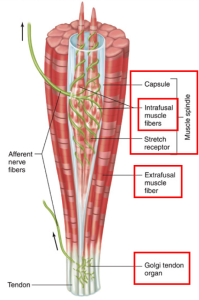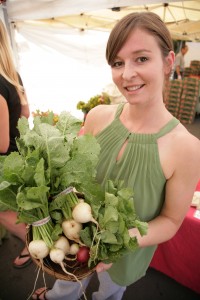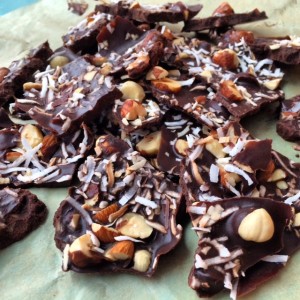The Science of Stretching
Post by Lily Gil, Personal Trainer, Nourish Northwest
The Science of Stretching
Most of us remember to do a quick stretch following an intense workout when our muscles are beginning to tense up. It feels good to lengthen those tight glutes or quads, after performing too many (aka the right amount) of squats and lunges. BUT, have you ever wondered what is going on in your muscles during a stretch or why after about 30 seconds into a toe touch stretch you can finally reach those toes? Read on to find out!
Mechanoreceptors are located inside muscles (and ligaments, bones, and joints) and are responsible for sensing distortion (i.e. stretching) in body tissue. Two types of mechanoreceptors that play a prominent role in muscle behavior are muscle spindles and Golgi tendon organs. Muscle spindles are sensitive to the change in length of a muscle and the rate at which that length change occurs, while Golgi tendon organs are sensitive to the change in tension of a muscle (i.e. how tense a muscle is) and the rate of that change. When a muscle is placed under excessive stress from being engaged/contracted for too long, the Golgi tendon organ kicks in, causing the muscle to relax and also prevent injury. On the other hand, when a muscle is lengthened, the muscle spindles are stretched and become excited, causing the extended muscle fibers to contract. This prevents the muscle from stretching too far too fast (i.e. hyper extending), which could cause injury.
Stick with me! Here’s how it plays into stretching.
When the Golgi tendon organ is excited for a prolonged period of time (at least 30 seconds according to National Academy of Sports Medicine), it provides an inhibitory effect to muscle spindles, which are trying to contract the muscle. This means, that when we hold a stretch for long enough, the Golgi tendon organ overrides the muscle spindle activity, causing relation in the overactive muscle, allowing for it to be stretched to its optimal length. It takes about 30 seconds for this override to occur, which is why it’s so important to hold stretches for solid amount of time in order to really stretch out a muscle.
There you are! Now when you’re struggling to reach your toes and stretch out those hamstrings, remember to hold the stretch and continue breathing into it for around 30 seconds in order for the muscles to begin to relax. Happy stretching!!
White Winter Soup
Post by Paula Jahn, Co-owner and Registered Dietitian & Cooking Instructor at Nourish Northwest
When people tell me they “don’t eat anything white,” I usually resist the urge to get technical. Sometimes, I can’t help but challenge. No cauliflower, onions, garlic, parsnips, apples, jicama, turnips, coconut, or white beans? Many people want a concrete food rule to follow in order to achieve better health or weight loss. The problem is, food and diet are much more nuanced and complicated. I know the purpose of that statement is to reduce or eliminate the intake of refined carbohydrates such as white bread, white rice, and other sweet confections. While such a rule has noble intentions, adhering to it without exception leaves out a world of pale food that is both healthful and delicious.
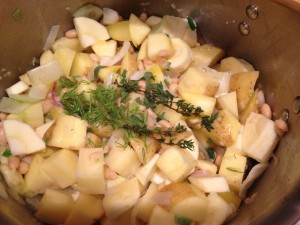
Food color is associated with particular antioxidants that confer specific health benefits. The most well-known example is the orange color (carrots, squash, sweet potatoes, etc) and beta-carotene with vision, immunity and wound healing. White foods have many types of antioxidants. Parsnips have falcarinol, falcarindiol, panaxydiol, and methyl-falcarindiol. These are anti-inflammatory, anti-cancer, antibacterial and anti-fungal.
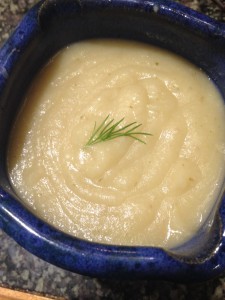
This white soup is especially good in the winter, when roots and tubers are plentiful and in season. I like to peel one third to one half of the skins on the vegetables. This imparts the right amount of earthiness and fiber while also yielding a silky texture. (Peel all of the parsnips since the skin is bitter and woody.)
White Winter Soup
(Adapted from Color Me Vegan by Coleen Patrick-Goudreau)
Ingredients
1 Tbs oil
3 cloves garlic, finely chopped or grated
1/2 white onion, chopped
1 shallot, chopped
3 whole green onions, choppped
1 inch piece ginger, grated or finely chopped
3 Yukon gold potatoes, half peeled and chopped
2 medium parsnips, peeled and chopped
1 Golden delicious or Granny Smith apple, chopped
1 can white beans, drained
1 tsp fresh dill, chopped
1 tsp dried or 2 tsp fresh tarragon
4 whole sprigs fresh thyme
6 oz dry white wine
3-4 cups vegetable to chicken stock
1/4 cup full-fat coconut milk
Salt and pepper to taste
Directions
- Heat oil over medium heat in a stock pot. Add onion, garlic, ginger, shallots and scallions and cook until fragrant, about 5 minutes.
- Add potatoes, parsnips, apple, beans, dill, tarragon, and thyme. Saute for 8 more minutes.
- Add wine and bring to boil for about 5 minutes. Pour in stock and bring to boil. Reduce to simmer and cook for 20 minutes, until all vegetables are tender.
- Add coconut milk and season with salt and pepper.
- Blend with an immersion blender or in batches in a regular blender. Serve warm.
fdfd
Recipe: Warm Lentil Salad
Post by Olivia Martino, Registered Dietitian and Co-Owner, Nourish Northwest
I love me some lentils! They are extremely filling, savory and nutritious. For this recipe, I like to use the French Green lentils because they really hold their shape when cooked. Do not use red lentils, as they will turn into a pile of mush! This recipe is also easy to make vegetarian by omitting the bacon. A little bit of goat cheese might be a nice addition, as well. Enjoy!
Warm French Lentil Salad with Bacon & Herbs
Makes 4 3/4-cup servings
1 cup green or French lentils
2 cups low-sodium or homemade chicken broth
1/4 teaspoon salt, plus more to taste
Freshly ground black pepper
4 ounces bacon (about 4 thick-cut slices), cut into small pieces
2 large shallots, cut in half and thinly sliced
4 cloves garlic, minced
3 large leaves sage, minced
2 tablespoons capers, roughly chopped
1/2 cup Italian parsley leaves, roughly chopped
For the dressing:
3 tablespoons extra-virgin olive oil
1 tablespoons Dijon mustard
1/2 tablespoon balsamic vinegar
Wash and rinse the lentils. Put in a small saucepan and cover with the chicken broth. Bring to a boil then lower to a simmer and cook until just tender, 20 to 25 minutes. Add extra water while cooking if the liquid gets low. Drain the lentils and return them to the pot. Stir in the salt.
Meanwhile, while the lentils are cooking, cook the bacon in a heavy pan over medium heat until crispy. Drain most of the fat out of the pan, then add the shallots, garlic and sage, and cook for 2 to 3 minutes or until the garlic is fragrant and the shallots are tender but not soft. Remove from the heat.
Whisk the olive oil, mustard, and balsamic vinegar together until thick. Toss with the warm, drained lentils, then stir in the bacon and shallot mixture. Stir in the chopped capers and parsley. Taste and season with additional salt, if needed, and a generous quantity of black pepper.
Serve warm. This keeps for 5 days in the refrigerator and is also good eaten cold.
Vacation?! Make sure to include a hike!
Post by Lily Gil, Personal Trainer and Fitness Instructor at Nourish Northwest
Winter is certainly upon us, and while I definitely prefer a nice chill in the air to sweltering 90 plus degree days, it can certainly put a damper on those outdoor activities.
As the cold is setting in, and you’re dreaming about next summer, imagine a trip where you’re seeing the most beautiful scenery, meeting locals but few tourists, eating all the yummy food you can imagine, AND EXERCISING enough to feel good about that belly full of local deliciousness? Sound too good to be true? Over this past summer my partner and I took advantage of having some time off, and trekked around Europe for a few weeks, under a pretty tight budget. We had been saving up over the year, and spending any free time searching for cheap(er) accommodations, finding deals on bus/train fares, and reading up on the best sights to see that didn’t cost an arm and a leg.
I didn’t realize this until we started researching, but Europe is known for its long distance walking/hiking trails. There are tons of them, ranging in distance, difficulty, and style. i.e. you can Glamp (glamorous camp) if you like, but you also don’t have to camp at all if you don’t want to. Check out this site to see what a few of them look like! As we encountered the array of hiking trail options via blogs and websites, we discovered one that didn’t require us to break our backs even more by carrying camping gear.
The Dingle Way, is located on the westernmost peninsula of Ireland. I cannot recommend a destination more than I recommend the Dingle Way. We only ended up doing part of it, as even the 20 lb packs of clothes ended up to be a bit too heavy after a few 20 mile days, but it was THE MOST AMAZING experience. Besides the most impressive views of the Blasket Islands and the sheep that befriended us as we hiked along the trail through their pastures, the best part of every day was being greeted by friendly Irish Airbnb hosts and sleeping in a cozy bed after a long day of hiking. The hiking certainly paid off as we ate our way through fresh fish and chips (fries), Irish milk chocolate, and grocery store sandwiches that tasted exquisite thanks to our post-hike taste buds.
This hiking-based travel experience was unlike any other trip, and I would highly recommend incorporating some sort of trail into your next vacation. There is truly no other way to experience the glory of another country, than by walking through glorious cattle pastures, hearing stories from fellow hikers about island sheep-tossing (not as cruel as it sounds, and I’m happy to tell the story at my next Tuesday class), and chatting with locals in the warmth of their own homes. So, as you’re thinking about the 90-degree days of July, and traveling to escape the heat, or to find a more tropical location, keep a hiking trip in the back of your mind. I guarantee, it will be unlike any past travel experiences and will make it so much easier to make it through that HIIT class when you return!
Or, take a staycation hike! Here are Olivia’s Top 5 Hikes in the Pacific Northwest.
Recipe: Dark Chocolate Coconut Bark
Post by Olivia Martino, Registered Dietitian and Co-Owner, Nourish Northwest
We develop many of own recipes or adapt them so many times from another recipe that they become our own. However, this one was just too good as is and did not need any changes. It comes from Oh She Glows, which is a great website for vegan recipes. We have been using this recipe for a lot lately for our Corporate Wellness Lunch and Learns because it’s a crowd pleaser and does not have any gluten, dairy or refined sugar, making it safe for many different diets. It’s also super easy to make, plus it’s a healthier alternative to the typical chocolate bark that you might find available commercially, with only 5 grams of sugar per serving compared to 25. You’re gonna be hooked on this stuff!
Crazy Good Coconut Oil “Chocolate” Bar
Ingredients:
- 1/4 cup raw hazelnuts
- 1/4 cup raw almonds
- 1/3 cup large flake dried coconut
- 1/2 cup virgin coconut oil
- 1/2 cup cocoa or cacao powder, sifted if necessary
- 1/4 cup pure maple syrup
- 1 tablespoon smooth almond butter, optional
- pinch fine sea salt
Directions:
- Preheat oven to 300F. Line a 9″ square pan or a small baking sheet with two pieces of parchment paper, one going each way. Set aside.
- Add hazelnuts and almonds on a baking sheet and roast in the oven for 10 minutes. Remove baking sheet and add the coconut flakes and spread out. Continue roasting the nuts and coconut flakes for another 3-4 minutes, or until the coconut is lightly golden. Watch closely to avoid burning – coconut burns fast!
- Place hazelnuts on several sheets of damp paper towel. Wrap the hazelnuts and rub them vigorously with the paper towel until the skins fall off. It’s ok if some skins don’t come off. Discard the skins and roughly chop the hazelnuts and almonds.
- In a medium saucepan, melt the coconut oil over low heat. Remove from heat and whisk in the cocoa (or cacao) powder, maple syrup, and almond butter (if using) until smooth. Add a pinch of sea salt to taste. Stir in half of the almonds and hazelnuts.
- With a spatula, spoon the chocolate mixture onto the prepared parchment-lined pan or sheet and smooth out until it’s about 1/4-1/2 inch thick. Sprinkle on the remaining nuts and all of the coconut flakes. Place into freezer on a flat surface for about 15 minutes, until frozen solid.
- Once frozen, break apart into bark. Store in the freezer until ready to eat. I don’t recommend keeping it out on the counter long because it melts fast.
Tip: To make this nut-free, simply omit the almond butter, hazelnuts, and almonds. It will still turn out just fine! You can try adding toasted sunflower seeds on top for a little crunch.
Read more: http://ohsheglows.com/2015/03/18/crazy-good-coconut-oil-chocolate-bark/#ixzz3txsmEpYv



